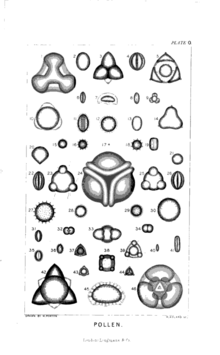
| Part of a series on |
| Forensic science |
|---|
 |
Forensic palynology is a subdiscipline of palynology (the study of pollen grains, spores, and other palynomorphs.), that aims to prove or disprove a relationship among objects, people, and places that may pertain to both criminal and civil cases.[1] Pollen can reveal where a person or object has been, because regions of the world, countries, and even different parts of a single garden will have a distinctive pollen assemblage.[2] Pollen evidence can also reveal the season in which a particular object picked up the pollen.[3] Recent research into forensic palynology has seen advancements in DNA barcoding from pollen, to the level of singular pollen molecules, allowing DNA profiles to be created from singular palynomorphs, streamlining the efficiency and accuracy of taxonomic identification.[4]
Palynology is the study of palynomorphs – microscopic structures of both animal and plant origin that are resistant to decay. This includes spermatophyte pollen, as well as spores (fungi, bryophytes, and ferns), dinoflagellates, and various other organic microorganisms – both living and fossilized.[5] There are a variety of ways in which the study of these microscopic, walled particles can be applied to criminal forensics.
In areas such as New Zealand, where the demand for this field is high, forensic palynology has been used as evidence in many different case types that range anywhere from non-violent to extremely violent crimes.[6] Pollen has been used to trace activity at mass graves in Bosnia,[7] pinpoint the scene of a crime,[6] and catch a burglar who brushed against a Hypericum bush during a crime.[8] Because pollen has distinct morphology and is relatively indestructible, it is likely to adhere to a variety of surfaces often without notice and has even become a part of ongoing research into forensic bullet coatings.[9]
- ^ Cite error: The named reference
:3was invoked but never defined (see the help page). - ^ Vaughn M. Bryant. "Forensic Palynology: A New Way to Catch Crooks". Archived from the original on 3 February 2007.
- ^ Robert Stackhouse (17 April 2003), "Forensics studies look to pollen", The Battalion, archived from the original on 23 April 2013
- ^ Bell, Karen L.; Burgess, Kevin S.; Okamoto, Kazufusa C.; Aranda, Roman; Brosi, Berry J. (1 March 2016). "Review and future prospects for DNA barcoding methods in forensic palynology". Forensic Science International: Genetics. 21: 110–116. doi:10.1016/j.fsigen.2015.12.010. ISSN 1872-4973. PMID 26751251.
- ^ Alotaibi, Saqer S.; Sayed, Samy M.; Alosaimi, Manal; Alharthi, Raghad; Banjar, Aseel; Abdulqader, Nosaiba; Alhamed, Reem (1 May 2020). "Pollen molecular biology: Applications in the forensic palynology and future prospects: A review". Saudi Journal of Biological Sciences. 27 (5): 1185–1190. doi:10.1016/j.sjbs.2020.02.019. ISSN 1319-562X. PMC 7182995. PMID 32346322.
- ^ a b Mildenhall, Dallas (2008). "Civil and criminal investigations. The use of spores and pollen". SIAK-Journal − Zeitschrift für Polizeiwissenschaft und polizeiliche Praxis (4): 35–52. doi:10.7396/2008_4_E.
- ^ Peter Wood (9 September 2004), Pollen helps war crime forensics, BBC News, retrieved 4 January 2010
- ^ D. Mildenhall (2006), "Hypericum pollen determines the presence of burglars at the scene of a crime: An example of forensic palynology", Forensic Science International, 163 (3): 231–235, doi:10.1016/j.forsciint.2005.11.028, PMID 16406430
- ^ Sermon, Paul A.; Worsley, Myles P.; Cheng, Yu; Courtney, Lee; Shinar-Bush, Verity; Ruzimuradov, Olim; Hopwood, Andy J.; Edwards, Michael R.; Gashi, Bekim; Harrison, David; Xu, Yanmeng (September 2012). "Deterring gun crime materially using forensic coatings". Forensic Science International. 221 (1–3): 131–136. doi:10.1016/j.forsciint.2012.04.021. PMID 22608265.
© MMXXIII Rich X Search. We shall prevail. All rights reserved. Rich X Search
